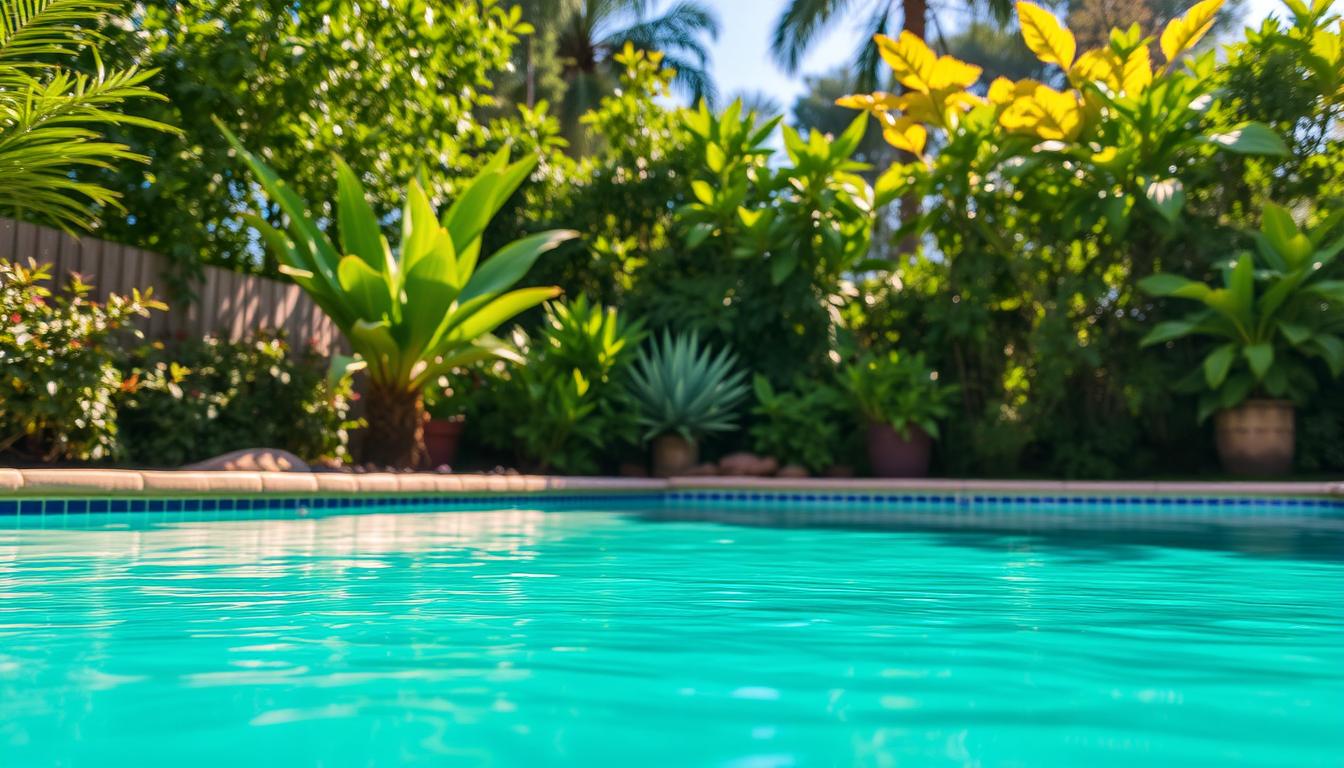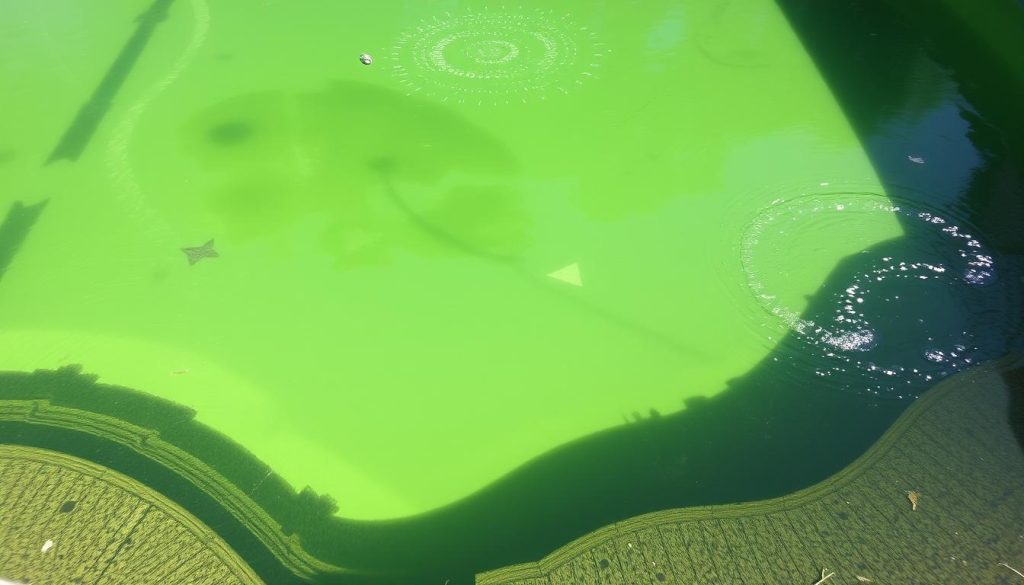
Our family was excited about our new backyard pool last summer. After a week of neglect, we found the water had turned murky green. Algae bloom had taken over, making us question the pool’s safety.
Swimming in a green pool can be risky. Green water often signals an algae infestation. This happens when chlorine levels are low and filtration is poor.
Algae blooms are common in summer. Warm water and more sunlight make pool sanitation crucial for swimming safety.
We’ll explore the dangers of green pools and what causes unsafe conditions. You’ll learn how to tell if a cloudy pool is safe to swim in.
We’ll also share tips for proper pool maintenance. This will help ensure a safe and fun swimming experience for everyone.
Understanding the Risks of Swimming in a Green Pool
Green pools can be dangerous for swimmers. They can cause illnesses, infections, and chemical imbalances. These issues can lead to eye irritation, breathing problems, and skin rashes.
It’s crucial to know these risks. By understanding them, we can protect ourselves and our families from harm.
Bacterial and Viral Illnesses
Green pools are perfect for harmful bacteria and viruses. These tiny invaders can make us very sick. Poorly maintained pools often contain dangerous pathogens.
- E. coli: Causes gastrointestinal issues like diarrhea and abdominal cramps
- Cryptosporidium: Leads to severe diarrhea, dehydration, and fever
- Giardia: An intestinal parasite that causes giardiasis, resulting in diarrhea, nausea, and stomach pain
- Legionella: Responsible for Legionnaires’ disease, a severe form of pneumonia
- Pseudomonas: Causes skin rashes, ear infections, and respiratory issues
Kids, older adults, and people with weak immune systems are at higher risk. They’re more likely to get sick from these waterborne illnesses.
Chemical Imbalances and Health Complications
Wrong chlorine levels and pH balance in green pools can cause health problems. Low chlorine lets bacteria and algae grow. Too much chlorine irritates eyes, lungs, and skin.
Unbalanced pH levels can also create issues:
| pH Level | Potential Health Issues |
|---|---|
| Too low (acidic) | Eye irritation, skin dryness, and corrosion of pool surfaces |
| Too high (alkaline) | Reduced chlorine effectiveness, skin irritation, and cloudy water |
Keeping the right chlorine levels and pH balance is key. It ensures a safe and healthy swimming environment for everyone.
“The importance of understanding the risks associated with swimming in a green pool cannot be overstated. By educating ourselves and taking proactive measures to maintain proper pool hygiene, we can significantly reduce the likelihood of contracting waterborne illnesses and experiencing health complications.”
Factors Contributing to Unsafe Swimming Conditions
Safe swimming requires attention to crucial factors. Neglecting these elements increases risks significantly. Let’s explore key aspects of an unsafe swimming environment.
Inadequate Water Circulation and Filtration
Proper circulation and filtration systems keep pool water clean and safe. Poor circulation leads to contaminant buildup, posing serious health risks to swimmers.
Regular maintenance prevents harmful substance accumulation. It’s vital to ensure optimal functioning of the pool’s filtration system.

Insufficient Chlorine Levels
Chlorine is crucial for pool water treatment. It kills harmful microorganisms and prevents algae growth. When levels drop below 1-3 parts per million, water becomes vulnerable to pathogens.
Low chlorine can cause illnesses, infections, and skin rashes. Regular monitoring and maintenance of chlorine levels ensure a safe swimming environment.
Unregulated Water Temperature
Water temperature greatly affects swimming safety and comfort. Cold water below 83°F can cause muscle cramps and fatigue. Warm water above 86°F promotes harmful microorganism growth.
Maintaining temperatures between 83°-86°F is crucial. This range ensures swimmer comfort and prevents microorganism proliferation.
| Factor | Recommended Range | Consequences of Imbalance |
|---|---|---|
| Chlorine Levels | 1-3 parts per million | Waterborne illnesses, algae growth |
| pH Levels | 7.2-7.8 | Skin and eye irritation, ineffective chlorine |
| Water Temperature | 83°-86°F (28°-30°C) | Muscle cramps, fatigue, microorganism growth |
Proper water circulation, chlorine levels, and temperature are essential. Maintaining these factors reduces risks of unsafe swimming conditions. This ensures a healthy, enjoyable experience for all swimmers.
Is It OK to Swim in a Green Pool?
Swimming in a green pool can be dangerous. Algae blooms, which cause green water, make it hard to see underwater. This increases the risk of accidents. Exposure to algae-filled water may cause eye, skin, and breathing problems.
Pool safety requires proper maintenance. Regular cleaning and monitoring of chlorine and pH levels are crucial. Ideal chlorine levels range from 1 to 3 ppm. The pH should be between 7.2 and 7.6.
Skimming, vacuuming, and filter cleaning help prevent algae growth. Water testing is also important. These tasks ensure safe swimming conditions for everyone.
Swimmers can take steps to protect themselves. Use test strips to check water quality before diving in. Avoid swallowing pool water. Cover open wounds and protect your ears.
Shower after swimming to remove any potential contaminants. Take regular bathroom breaks to maintain water cleanliness. These actions help reduce health risks associated with green pool water.
A well-maintained pool is safe and enjoyable for all. By working together, we can keep pool water clean and healthy. This ensures a fun and worry-free swimming experience.







